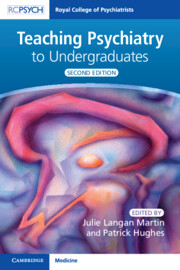Book contents
- Teaching Psychiatry to Undergraduates
- Teaching Psychiatry to Undergraduates
- Copyright page
- Contents
- Contributors
- Section 1 Principles of Medical Education
- Section 2 The Undergraduate Psychiatry Curriculum: Planning and Delivery
- Chapter 2.1 Understanding Curriculum Design
- Chapter 2.2 Preclinical Versus Clinical Years
- Chapter 2.3 Patients as Educators in Psychiatry: The Ethical and Educational Case
- Chapter 2.4 Assessment of Undergraduates in Psychiatry
- Chapter 2.5 Beyond the Undergraduate Core Curriculum
- Chapter 2.6 Supporting the Psychiatrists of Tomorrow
- Section 3 Clinical Placements in Psychiatry
- Section 4 Formal Teaching
- Section 5 Materials Development
- Section 6 Gathering feedback and quality improvement
- Section 7 Student Welfare
- Section 8 Developing as a medical educator
- Index
- References
Chapter 2.2 - Preclinical Versus Clinical Years
from Section 2 - The Undergraduate Psychiatry Curriculum: Planning and Delivery
Published online by Cambridge University Press: 12 October 2022
- Teaching Psychiatry to Undergraduates
- Teaching Psychiatry to Undergraduates
- Copyright page
- Contents
- Contributors
- Section 1 Principles of Medical Education
- Section 2 The Undergraduate Psychiatry Curriculum: Planning and Delivery
- Chapter 2.1 Understanding Curriculum Design
- Chapter 2.2 Preclinical Versus Clinical Years
- Chapter 2.3 Patients as Educators in Psychiatry: The Ethical and Educational Case
- Chapter 2.4 Assessment of Undergraduates in Psychiatry
- Chapter 2.5 Beyond the Undergraduate Core Curriculum
- Chapter 2.6 Supporting the Psychiatrists of Tomorrow
- Section 3 Clinical Placements in Psychiatry
- Section 4 Formal Teaching
- Section 5 Materials Development
- Section 6 Gathering feedback and quality improvement
- Section 7 Student Welfare
- Section 8 Developing as a medical educator
- Index
- References
Summary
Psychiatry has traditionally been taught as a ‘horizontal’ module in the 4th/5th year of medical curricula. Increasingly, there is emphasis on teaching psychiatry across the curriculum. This approach makes intuitive sense, is integral to the GMC’s principles of medical education, and is welcome. It allows important work to be done in reducing stigma, encouraging student awareness of how to ensure wellness and resilience across a career in medicine, improves recruitment to the specialty, and empowers future doctors to practise medicine in a truly holistic way (as opposed to the biomedical model that has predominated in the last century).
However, there are challenges to teaching psychiatry across preclinical and clinical years. These include tailoring content to students’ needs, finding space within an increasingly dense and complex curriculum, and mapping content effectively. Ensuring effective and comprehensive assessment of content which is interspersed across preclinical and clinical years has been difficult, and measuring effectiveness of content which aims to establish attitudinal change and improve long-term wellbeing is inevitably ambiguous.
- Type
- Chapter
- Information
- Teaching Psychiatry to Undergraduates , pp. 30 - 34Publisher: Cambridge University PressPrint publication year: 2022

